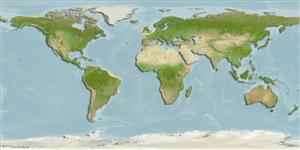>
Blenniiformes (Blennies) >
Blenniidae (Combtooth blennies) > Salariinae
Etymology: Hypleurochilus: Greek, hypo = under + Greek, pleura = in the side of + Greek, cheilos = lip.
More on authors: Quoy & Gaimard.
Environment: milieu / climate zone / depth range / distribution range
Ecologia
marino demersale. Tropical
Southwest Atlantic: Paraíba, Brazil (Ref. 57756) to Uruguay (Ref. 35204) and Argentina (Ref. 86332). Northeast Atlantic: Azores (Ref. 35204).
Size / Peso / Age
Maturity: Lm ? range ? - ? cm
Max length : 8.9 cm TL maschio/sesso non determinato; (Ref. 116953)
Adults feed primarily on amphipods and isopods (Ref. 9062). Oviparous. Eggs are demersal and adhesive (Ref. 205), and are attached to the substrate via a filamentous, adhesive pad or pedestal (Ref. 94114). Larvae are planktonic, often found in shallow, coastal waters (Ref. 94114).
Life cycle and mating behavior
Maturities | Riproduzione | Spawnings | Egg(s) | Fecundities | Larve
Oviparous, distinct pairing (Ref. 205).
Menezes, N.A. and J.L. Figueiredo, 1985. Manual de peixes marinhos do sudeste do Brasil. V.Teleostei (4). Museu de Zoologia, Universidade de São Paulo, Brazil. 105 p. (Ref. 9062)
IUCN Red List Status (Ref. 130435)
Threat to humans
Harmless
Human uses
Strumenti
Special reports
Download XML
Fonti Internet
Estimates based on models
Preferred temperature (Ref.
123201): 14.9 - 27.7, mean 23.6 °C (based on 330 cells).
Phylogenetic diversity index (Ref.
82804): PD
50 = 0.5005 [Uniqueness, from 0.5 = low to 2.0 = high].
Bayesian length-weight: a=0.00813 (0.00432 - 0.01529), b=3.02 (2.85 - 3.19), in cm total length, based on LWR estimates for this species & (Sub)family-body (Ref.
93245).
Trophic level (Ref.
69278): 3.3 ±0.53 se; based on food items.
Resilienza (Ref.
120179): Alto, tempo minimo di raddoppiamento della popolazione meno di 15 mesi (Preliminary K or Fecundity.).
Fishing Vulnerability (Ref.
59153): Low vulnerability (10 of 100).
